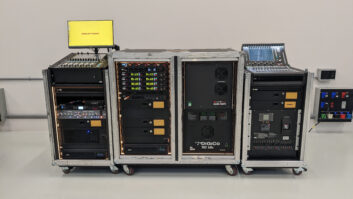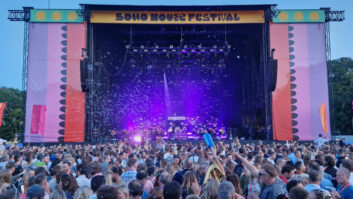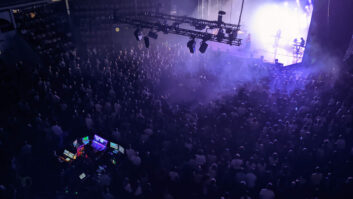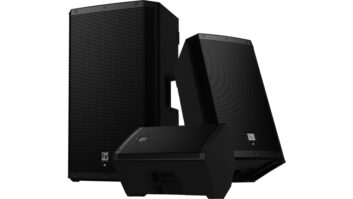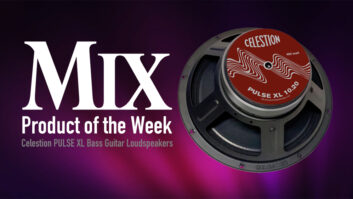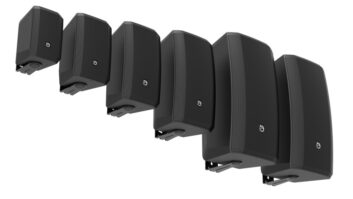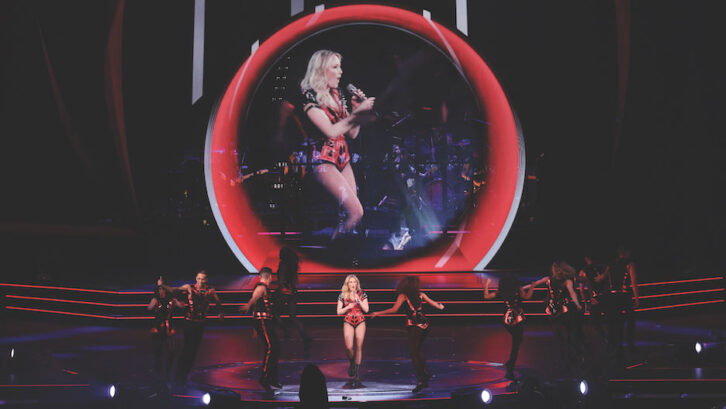
New York, NY (July 19, 2023)—Whether driven by a desire to save money or save the planet, artists have a growing number of options when it comes to the latest generation of touring sound technologies.
Of course, the two impulses are not mutually exclusive; indeed, they reinforce each other. Touring with smaller and lighter mixing consoles and line arrays can significantly reduce transport costs, as one example, through a reduction in the number of trucks and associated fuel and labor costs and, as a result, the carbon footprint of the entire venture.
There are knock-on effects, too. Lighter speakers may reduce load-in, setup and teardown times. Smaller, lighter speakers can also reduce some of the limitations on a show’s lighting, video and other production design elements. A smaller desk takes up less space at the FOH mix position, which enables the promoter to sell more seats.
To be clear, these new technologies may be smaller and lighter, but that doesn’t mean that their performance or capabilities are compromised. Indeed, these products may be more efficient in terms of space, weight and running costs, but they are no less powerful than other products from the same manufacturers.
Plenty of bands have sung about climate change over the decades, but the impulse to do the right thing regarding the threat of global warming has led some artists to get proactive on tour in recent years.
Coldplay, Massive Attack, Billie Eilish and The 1975, to name but a few, have variously pledged to reduce the carbon footprint of their tours, promoted and implemented recycling initiatives at gigs and provided data to researchers studying bands’ touring emissions. One major artist was even the impetus behind one of these new efficient, cost-saving and green products.
THE LOUDSPEAKERS
When Ed Sheeran adopted an in-the-round stage show a couple of years ago, his longtime production manager, Chris Marsh, of UK production provider Major Tom, approached Meyer Sound about developing a smaller, lighter box with a lower power draw than Leo, which he had been using. “He had a new structure, where weight was going to be a major issue,” recalls Andy Davies, Meyer Sound’s UK-based senior product manager. “And he had an artist asking his team to consider the environmental impacts of all of the decisions that they made.”
Meyer Sound has been recognized as a Bay Area Green Business since 2016, a reflection of company owners John and Helen Meyer’s passions and personal sense of responsibility. “So it’s not new to us to think like this,” Davies says.
Modern, complex productions have added a new variable to rigging safety considerations, he continues: “There’s more and more automation for set pieces, video pieces and lighting pieces that move during the show. The overall weight loading is no longer calculated by how much elements weigh but by their momentum stopping weight if the power goes off during a move. That can significantly increase the overall weight of the production in the rigging safety calculations. So we needed to look for lighter solutions to fit in—which all dovetails with the green aspects. And that was really the spark that pushed Panther into happening,” he says. Despite a relatively short lead time between the request and the start of Sheeran’s tour, Meyer Sound’s design teams were up to the challenge. “That’s because of the way our engineering team is organized and the way they understand each other. Our acoustics team literally sits next to the electronics team and the amplifier team,” Davies says.
Panther offers a 20 percent power draw saving over previous comparable products, while its compact form factor and lighter weight occupies considerably less space during transport. “We’ve paid particular attention to how efficient it is on a truck pack,” Davies notes.
Meyer Sound points to a UK survey that found a single diesel semi-truck covering 10,000 miles can generate a carbon footprint of 17.3 U.S. tons (15.7 metric tons). Taking out a system anchored by 212 Panther boxes reduced the Sheeran tour’s truck count from five to three, with a similar reduction in sea freight shipping containers, a significant cost saving in addition to the green benefits. (All that said, the single biggest contributor to any show’s emissions is audience transportation to and from the event.)
Fewer trucks require fewer drivers. “And if you’re reducing [speaker] weight and size, that requires fewer people to ensure safe handling,” Davies adds. “A forklift driver may only need one assistant rather than two.” That’s not a big deal on a production with a crew call in the hundreds, he adds, “But on smaller shows, it makes a very real difference.”
THE FULL STAGE
You may not have heard of Helene Fischer, but her popularity with German-speaking audiences rivals the likes of Rihanna and Céline Dion. Her current arena show, created with Cirque du Soleil, fills 30 trucks, with a lot of the contents—lighting, video, aerial acrobatics apparatus—suspended overhead. With so much going on above the stage, says Holger Schader, senior consultant, touring and special events for production provider Solotech in Germany, the P.A. had to be light and compact.
“There needed to be a system which has a smaller footprint than usual but that is powerful enough,” he says. Fortuitously, Solotech is a partner in L-Acoustics’ pilot program as the manufacturer begins to roll out its new L Series progressive, ultra-dense line source speaker system, which will become commercially available later this year.
All told, there are 60 tons of gear flown in the roof on Fischer’s current tour, a series of five-day residencies at arenas across Germany, Austria and Switzerland. “If we had gone for a standard solution, we would have had at least two to two and a half tons more on just the audio side,” Schader says. “The weight difference is essentially between 40 and 50 percent compared to a [L-Acoustics] K1 or K2 rig. With Helene Fischer, we saved one truck.”
L Series came about after L-Acoustics analyzed hundreds of projects and found that two elements, the L2 and L2D, flown separately or together in a fixed geometry, could satisfy most applications with little compromise in power, coverage or consistency compared to the company’s other products. L Series requires 56 percent less paint, 30 percent less wood and 60 percent less steel, according to L-Acoustics, resulting in 30 percent less volume and 25 percent less weight compared to an equivalent line array box.
Due to the limited number of L Series boxes available on the pilot program, the tour also uses K3 for the 270-degree hangs, or else the weight and space savings would have been greater, he says. When considering speaker options for a tour, there may be associated weight savings, he also points out, with larger boxes needing a heavier hoist compared to smaller array elements, as well as power consumption differences.
One other benefit of L Series is that it reduces setup mistakes, Schader says, as the angles between array elements are fixed. That hasn’t translated into manpower savings on the Helene Fischer tour, due to the production’s overall complexity and the K3 side hangs. “So it still takes about six hours to load out on a good night,” he reports.
